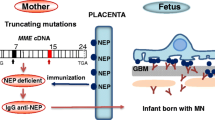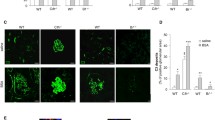Abstract.
Proteinuria in passive Heymann nephritis (PHN) results from complement-mediated glomerular injury, since complement depletion with cobra venom factor (CVF) prevents proteinuria. However, there are no comprehensive morphological studies identifying the sites of injury leading to onset of proteinuria. To address this issue, we attempted to locate sites of injury involved in the onset of proteinuria in PHN. PHN was induced in intact Munich-Wistar rats (PHN-rats, examined at days 3, 5, and 7) and in complement-depleted rats (CVF treated, PHN-CVF-rats, examined at days 3 and 5). The distribution of endogenous albumin in the glomerular basement membrane (GBM) was studied in in situ drip-fixed glomeruli using immunogold immunocytochemistry, and glomerular anionic sites were visualized by polyethyleneimine staining. In addition, the ultrastructural localization of an epitope recognized by a proteinuria-inducing monoclonal antibody (called 5-1-6) directed against the slit diaphragm was examined. Significant proteinuria was seen in intact PHN-rats, starting at day 5. The intensity of gold labeling for endogenous albumin was significantly increased at the outermost site of the GBM (GBM interfacing foot process and the filtration slit, designated area O) at day 3 in both PHN-rats and PHN-CVF-rats in comparison to untreated controls. At day 5, labeling for albumin in area O was decreased in PHN-rats, but not in PHN-CVF-rats, where it was then higher; in PHN-rats, some areas between epithelial cells and subepithelial deposits were almost free of albumin labeling at day 7. There was no evidence of epithelial cell detachment in any group at day 5, but on day 7 limited focal detachment was seen exclusively in PHN-rats. In proteinuric rats, amorphous material that stained for albumin could be seen in the urinary space, without any exocytosis of labeling by glomerular epithelial cells. A significant reduction of intensity of staining for anionic sites was seen in parallel in both groups, but only in the regions of the lamina rara externa adjacent to subepithelial deposits. This local loss of charge might contribute to enhanced permeability to albumin in both PHN- and PHN-CVF-rats. Changes in the appearance of the filtration slits and in the density and distribution of antigen recognised by monoclonal antibody 5-1-6 were similar in PHN- and PHN-CVF-rats at day 5. Complement depletion prevented neither the reduction in anionic sites of the GBM nor the changes in the slit diaphragm observed. These data suggest that albumin leakage between the epithelial cell and the GBM (area O) could occur in PHN-rats, perhaps as a result of epithelial foot-process changes. This may be the final link in the chain of events responsible for the onset of proteinuria in PHN.
Similar content being viewed by others
Author information
Authors and Affiliations
Additional information
Electronic Publication
Rights and permissions
About this article
Cite this article
Fujigaki, Y., Batsford, S., Yamashita, F. et al. Sequence of events in the glomerular capillary wall at the onset of proteinuria in passive Heymann nephritis. Virchows Arch 438, 136–145 (2001). https://doi.org/10.1007/s004280000295
Received:
Accepted:
Issue Date:
DOI: https://doi.org/10.1007/s004280000295




